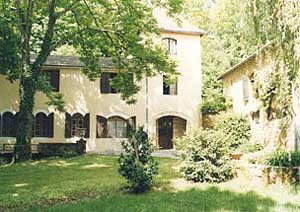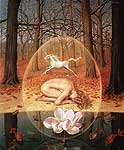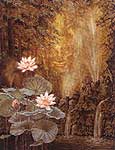|
|

MOULIN DU PEUCH
|
In June of 1973, Lórien and Johfra bought a property in the West of France. One year later, they moved there, to an old mill at the foot of a chateau in Dordogne. They renovated it, preserving the stream that ran under the home, and called it Moulin du Peuch.
All this time, she signed her works under the name of Ellen Lórien. She chose the name Lórien in hommage of Tolkien, and his land of elves, Loth Lórien - a name that evokes the rich country of flowers and dreams.
Along with Johfra, Lórien participated in a large travelling exhibition in 1974. As one of the Seven Meta-Realists, her paintings garnered much attention, and she was soon known throughout Holland.
|
|
|
|
|

THE TRINITY
|

THE SILENT SPRING
|
In 1975, a meeting with Gyalwa Karmapa led to Lórien’s increasing involvement with the Tibetan community that had settled in the hills near their home. She studied Tibetan and immersed herself in their customs and beliefs. Her paintings, which continued to manifest a deep fascination with Women, Nature, and Spirituality, began to incorporate more Buddhist motifs.
A journey to Venice in 1977 made a profound impression on both her and Johfra. Eventually Venetian motifs would begin to appear in their respective works. That same year, Lórien founded Galerie la Licorne on their property. Aside from their own work, this gallery exhibited French and Dutch artists, most notably Carjan (Car and Jan Verheul). Lórien also continued to exhibit her works in Holland at Galerie Kamp.
|
|
|
|


